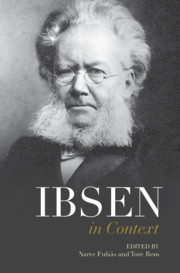Book contents
- Ibsen in Context
- Ibsen in Context
- Copyright page
- Contents
- Figures
- Contributors
- Preface
- Notes on the text
- Chronology
- Part I Life and Career
- Chapter 1 Early Years in Norway
- Chapter 2 From Theatre to Book
- Chapter 3 Bourgeois Drama
- Part II Culture and Society
- Part III Scandinavian Reception
- Part IV Internationalization
- Part V Afterlives
- Further Reading
- Index
Chapter 3 - Bourgeois Drama
from Part I - Life and Career
Published online by Cambridge University Press: 23 April 2021
- Ibsen in Context
- Ibsen in Context
- Copyright page
- Contents
- Figures
- Contributors
- Preface
- Notes on the text
- Chronology
- Part I Life and Career
- Chapter 1 Early Years in Norway
- Chapter 2 From Theatre to Book
- Chapter 3 Bourgeois Drama
- Part II Culture and Society
- Part III Scandinavian Reception
- Part IV Internationalization
- Part V Afterlives
- Further Reading
- Index
Summary
A Doll’s House (1879) and Ghosts (1881) represented major reorientations of Ibsen’s dramatic authorship, initiating a turn to middle-class life treated with tragic seriousness and radicalism. These plays made Ibsen the spearhead of the Scandinavian ‘Modern Breakthrough’, reaffirming his literary superiority, while at the same time bringing new levels of commercial success. The reorientation was made possible by the literary dynamics unfolding in Scandinavia at the time. By the early 1880s, Ibsen gave up on his ambition to get a foothold in Germany, moved back to Italy (1880–5) and once more prioritized his home markets. His association with the Literary Left was not a lasting one, however. With An Enemy of the People (1882) and The Wild Duck (1884), he distanced himself from social criticism and gradually established a position all his own. Moving back again to Munich (1885–91), he eventually experienced a breakthrough also in German literature and theatre from 1887, followed by Britain from 1889. After Ibsen again settled in Norway in 1891, he wrote for a European market, concluded his production with a series of self-reflective plays, and tried to frame his oeuvre as a continuously unfolding and self-sufficient whole.
- Type
- Chapter
- Information
- Ibsen in Context , pp. 19 - 26Publisher: Cambridge University PressPrint publication year: 2021
- 1
- Cited by

